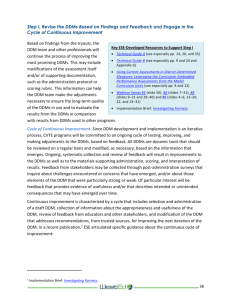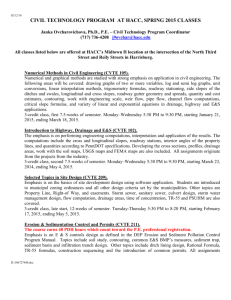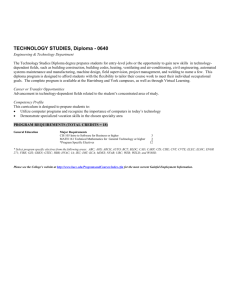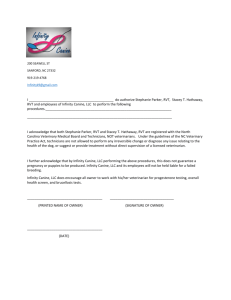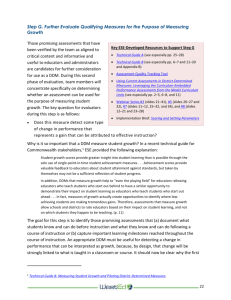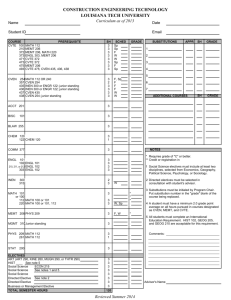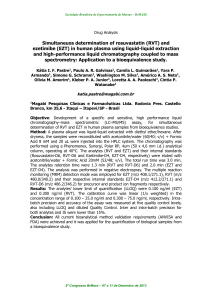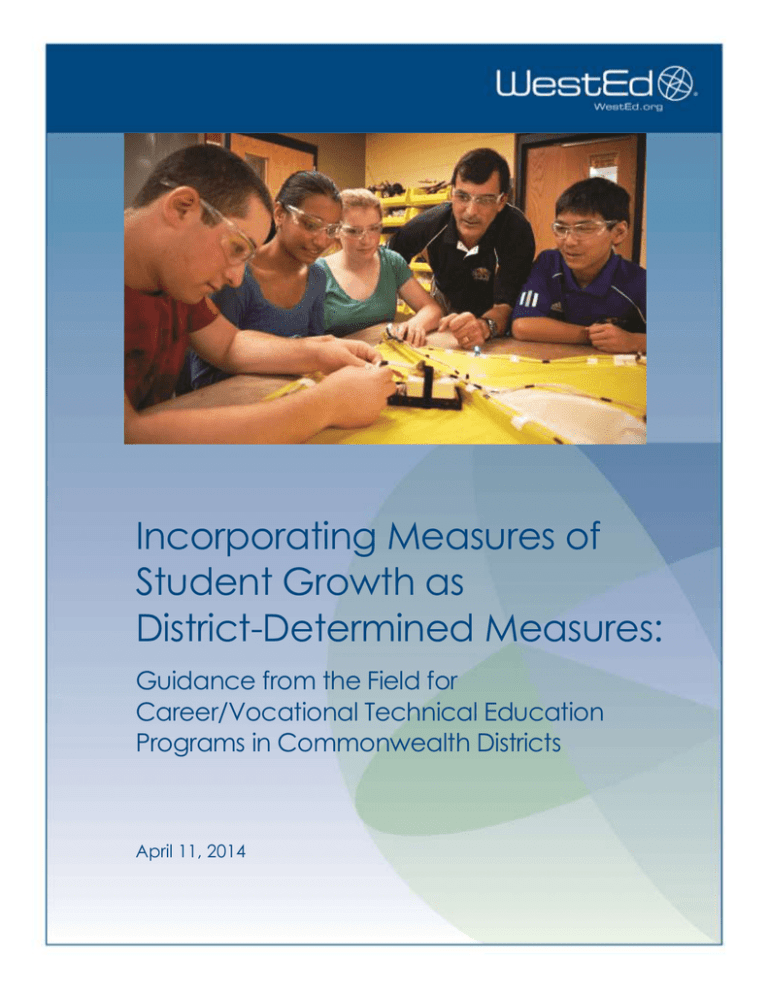
Incorporating Measures of
Student Growth as
District-Determined Measures:
Guidance from the Field for
Career/Vocational Technical Education
Programs in Commonwealth Districts
April 11, 2014
WestEd—a national nonpartisan, nonprofit research, development,
and service agency—works with education and other communities to
promote excellence, achieve equity, and improve learning for
children, youth, and adults. WestEd has 16 offices nationwide, from
Washington and Boston to Arizona and California, with its
headquarters in San Francisco. For more information about WestEd,
visit WestEd.org; call 415.565.3000 or, toll-free, (877) 4-WestEd; or write:
WestEd / 730 Harrison Street / San Francisco, CA 94107-1242.
© 2014 WestEd. All rights reserved.
Table of Contents
Acknowledgments
i
Introduction
vii
Section I.
11
Overview of DDM Implementation in the CVTE Context: Perspectives
from CVTE Educators and Administrators
11
Opportunity to Specify the Knowledge and Skills Most Important for
Students to Learn and How Best to Measure Them
11
Opportunity to Bridge Academic Content and Technical Skills
13
Opportunity to Emerge as Leaders in Implementation of Effective
Measures of Growth
15
Opportunity to Improve the Practice of Teaching
17
Section II.
Steps in the DDM Development and Implementation Process, with Lessons
Learned from the Field
Stage 1. Planning
Step A. Build the DDM Team and Set Goals
Step B. Reach Agreement on Instructional Priorities or Critical Content
for Each Course
Step C. Plan for Ongoing Communication with Stakeholders
Stage 2. Exploring
Step D. Brainstorm All Possible DDM Options
Step E. Collect Promising Existing Measures and/or Develop New Ones
Stage 3. Evaluating
Step F. Evaluate Collected Measures for Use as DDMs: Two Key Criteria
Step G. Further Evaluate Qualifying Measures for the Purpose of
Measuring Growth
Stage 4. Testing and Revising
Step H. Administer Selected Measures
Step I. Revise the DDMs Based on Findings and Feedback and Engage
in the Cycle of Continuous Improvement
Section III.
Lessons Learned from the CVTE Community: In-Depth Profiles
District DDM Profile #1. Attleboro Public Schools
District DDM Profile #2. Southeastern Regional Vocational Technical
DDM District Profile #3: Tri-County Regional Vocational Technical
Appendices A–D
See attachments
Appendix A: Exemplar DDMs Developed by CVTE Educators Referenced
in this Guidance Document
Appendix B: ESE Resources Referenced in this Guidance Document for
CVTE Programs Seeking Additional Information about DDM Identification,
Development, and Implementation
Appendix C. Recommended External Resources on Measuring Student
Growth: Guidance from the Research and Measurement Communities
Appendix D: WestEd Tools and Outputs from Meetings with CVTE
Educators and Administrators
D-1: Summary of the Stages and Steps in the DDM Development
and Implementation Process
D-2: District-Determined Measures Review and Discussion Guide
D-3: Suggested Core Content Standards from CVTE Educators
D-4: Using Core Course Objectives to Support Selection of High
Quality District-Determined Measures: Guidance for Massachusetts
Districts
Acknowledgments
WestEd wishes to recognize those individuals who supported our work in the field with
Commonwealth educators and administrators and who contributed substantively to the
development of this report:
Tim Broadrick, Technical Director, Shawsheen Valley Regional Vocational Technical
School District
Tom Hickey, Superintendent-Director, South Shore Vocational Technical High School
Ron Noble, Educator Evaluation Project Lead, Massachusetts Department of
Elementary and Secondary Education (ESE)
Maura Russell, Career/Vocational Technical Education Unit, ESE
We would like to thank Tom Belland and Andrew Morrison for permission to use the image
from Blackstone Valley Regional Vocational Technical High School for the cover of this
report.
We also would like to thank all of the career/vocational technical education (CVTE) educators
and administrators from across the state who participated in meetings held in January and
February 2014 and submitted sample assessments that are featured in this report:
Career Cluster
Agricultural and
Natural Resources
Arts and
Communication
Business and
Consumer Services
Educators and
Administrators
District/Organization
William Florek
Berkshire Hills
Aaron Polansky
Bristol County Agricultural
Janis Gentile
Lower Pioneer Valley Education Collaborative
Sarah Ard
Minuteman RVT
Dhimitri Skende
Worcester Technical High School
Michele Watson Maxwell
Cambridge Rindge & Latin School
Barbara Jean Chauvin
Norfolk County Agricultural
Michael Azevedo
Shawsheen Valley RVT
John Brochu
South Middlesex RVT
Leslie Weckesser
Southeastern RVT
Diane Potter
Bristol-Plymouth RVT
Deborah Lagasse
Greater Lowell RVT
Maureen Griffin
Greater Lowell RVT
i
Career Cluster
Construction
Education
Health Services
Hospitality and
Tourism
Educators and
Administrators
District/Organization
Cheryl English
Peabody High School
Rosemary Slattery
Peabody High School
Elizabeth Alicea
Southern Worcester County RVT
Beverly DeSalvo
Whittier RVT
Leanne Lyons
Whittier RVT
John Foisy
Worcester Technical High School
Andrea Deane
Worcester Technical High School
Eileen Homen
Attleboro High School
Thomas Aubin
Greater Fall River RVT
John Hardacre
Greater Lawrence RVT
Oscar Amaral
Greater New Bedford RVT
Thaddeus Haggerty
Greater New Bedford RVT
Russell Esau
Leominster Center for Technical Education
John Manetta
Medford Vocational HS
Peter Maxfield
Montachusett RVT
Edward Carll
South Shore RVT
Jeremy Guay
Southern Worcester County RVT
Matthew Gomes
Westfield High School
James Smith
Worcester Technical High School
Susan Edmonds
Attleboro High School
Karla Boudreau
Greater Lowell RVT
Donald Jarvis
Lower Pioneer Valley Education Collaborative
Michelle Roche
Minuteman RVT
Julie Bowen
Weymouth High School
Sheri Membreno
Attleboro High School
Emily Lebo
Boston Public Schools
Diane Norkiewicz
Greater Lawrence RVT
Linda Cote
Greater Lowell RVT
Rosemary Pisani
Greater Lowell RVT
Erin Marcotte
Greater New Bedford RVT
Susan Lahtinen-Phelps
Leominster Center for Technical Education
Kathleen Holman
North Shore RVT
Deborah Collins
South Shore RVT
Mike Ananis
Cambridge Public Schools
Caroline Freitas
Cape Cod Regional
ii
Career Cluster
Information
Technology Services
Legal and Protective
Services
Manufacturing and
Engineering
Transportation
Educators and
Administrators
District/Organization
Cheryl Learned
Boston Public Schools
Janice Mosko
Greater Lowell RVT
Heidi Riccio
Medford Public Schools
Linda Millard
South Middlesex RVT
Robert Libenson
Weymouth High School
Cathie Baines
Whittier RVT
Jocelyn Croft
Franklin County RVT
Paul McNeil
Greater Lowell RVT
Frank Mann
Lower Pioneer Valley Education Collaborative
Marcia Kessler
Old Colony RVT
Tim Broadrick
Shawsheen Valley RVT
Christopher Hickman
Southern Worcester County RVT
Kimberly Zogalis
Tri-County RVT
Donald Conaghan
Whittier RVT
Jacqueline Striano
Dighton-Rehobeth
Kellie Martin
Greater New Bedford RVT
Jean George
Tri-County RVT
Heidi Getchell-Bastien
Tri-County RVT
Robert Cantin
Chicopee Public Schools
Carl Ingram, Jr.
Chicopee Public Schools
Cherilee Lewis
Greater Lawrence RVT
Robert Sullivan
Greater Lowell RVT
Todd Rathier
Leominster Center for Technical Education
Paul Goodrich
Minuteman RVT
Genevieve Castillo
Montachusett RVT
Donna Costa
Peabody High School
Richard Brady
Pittsfield High School
Robert Pierangeli
Tri-County RVT
Christopher Cummings
Waltham Public Schools
Cathie Rebelo
Weymouth Public Schools
Annette Cochran
Worcester Technical High School
Brian Cummings
Worcester Technical High School
Roy Doucette
Cambridge Rindge & Latin School
Don Ducharme
Greater Lowell RVT
Joseph Kinch
Medford High School
iii
Career Cluster
Educators and
Administrators
District/Organization
Justin Kratz
Northern Berkshire RVT
John Mare
Old Colony RVT
Marc Darisse
Salem High School
Leo DeSimone
Somerville Public Schools
Raymond Beck
Southern Worcester County RVT
In addition, we would like to thank those educators and administrators who responded to the
DDM collection survey and submitted sample assessments for possible use as DDMs, many of
which were shared with panelists at the January and February meetings:
Contributor
District/Organization
Career Cluster or CVTE Program
Affiliation
Oscar Amaral
Greater New Bedford RVT
Plumbing
Michael Ananis
Camb ridge Public Schools
Executive Director, Rindge School of
Technical Arts
Julie Archer
Bristol-Plymouth RVT
Dental Assisting
Sarah Ard
Minuteman RVT
Horticulture
Michael Azevedo
Shawsheen Valley RVT
Design & Visual Communications
Phanenca Babio
Boston Public Schools
Vocational Coordinator - Animal Science
Thomas Belland
Blackstone Valley RVT
Plumbing, Automotive Technology,
Carpentry, Health Assisting
Karla Boudreau
Greater Lowell RVT
Early Education and Care
Richard Brady
Pittsfield Public Schools
Biotechnology
Tracy Brett
Bristol-Plymouth RVT
Biotechnology
John Brochu
South Middlesex RVT
Vice Principal
Anne Cabucio
Fall River School District
Health Assisting
Robert Cantin
Chicopee Public Schools
Machine Tool Technology
Edward Carll
South Shore RVT
Electricity
Genevieve Castillo
Montachusett RVT
Drafting
Aaron Caswell
Bristol County Agricultural High School
Environmental Science & Technology
Annette Cochran
Worcester Public Schools
Engineering Technology
Donna Costa
Peabody High School
Manufacturing, Engineering &
Technological Occupational Cluster
Linda Cote
Greater Lawrence RVT
Health Assisting
iv
Contributor
District/Organization
Career Cluster or CVTE Program
Affiliation
Lindsay Cunniff
Attleboro High School
Culinary Arts
Marc Darisse
Salem High School
Automotive Technology
Andrea Deane
Worcester Technical High School
Marketing
Robert Dell'Ova
Medford Public Schools
Automotive Technology
Roy Doucette
Cambridge Public Schools
Automotive Technology
Rick Dutra
Old Colony RVT
Electronics
Susan Edmonds
Attleboro High School
Vocational Director
Cheryl English
Peabody High School
Cosmetology
Chris Faucher
Southern Worcester County RVT
HVAC
William Florek
Berkshire Hills
Horticulture
Caroline Freitas
Cape Cod Regional
Culinary Arts
Kathleen Garcia
Fall River Public Schools
Early Education and Care
Heidi Getchell-Bastien
Tri-county RVT
Legal & Protective Services Cluster
Matthew Gomes
Westfield High School
Carpentry
Paul Goodrich
Minuteman RVT
Biotechnology
Stephanos Gregory
Leominster Center for Technical
Education
Plumbing
John Hardacre
Greater Lawrence Technical High School
Electricity
Kathleen Holman
North Shore RVT
Health Assisting
Eileen Homen
Attleboro High School
Carpentry
Joe Kinch
Medford Public Schools
Automotive Collision Repair & Refinishing
Susan Lahtinen-Helps
Leominster Center for Technical
Education
Health Assisting
Emily Lebo
Boston Public Schools
CTE Director
Cherilee Lewis
Greater Lawrence Technical High School
Biotechnology
Robert Libenson
Weymouth Public Schools
Culinary Arts
Leanne Lyons
Whittier RVT
Marketing
Jackie Machamer
Old Colony RVT
Assistant Principal and Vocational Technical
Education Coordinator
John Manetta
Medford Public Schools
Metal Fabrication & Joining Technologies
Al Maral
Old Colony RVT
Drafting
Erin Marcotte
Greater New Bedford Vocational
Technical High School
Medical Assisting
John Mare
Old Colony RVT
Automotive Technology
v
Contributor
District/Organization
Career Cluster or CVTE Program
Affiliation
Peter Maxfield
Montachusett RVT
Carpentry
Sheri Membreno
Attleboro High School
Culinary Arts
Linda Millard
South Middlesex RVT
Culinary Arts
Janice Mosko
Greater Lowell RVT
Hospitality Management
Dianne Norkiewicz
Greater Lawrence Technical High School
Health Assisting
Lori Pelletier
Norfolk County Agricultural High School
Vocational Coordinator-Animal Science
Cathie Rebello
Weymouth Public Schools
CTE Director
Michelle Roche
Minuteman RVT
CTE Director
Kenneth Rocke
Pioneer Valley District and School
Assistance Center
Carpentry
Rosemary Slattery
Peabody High School
Business/Office Technology
Kathleen Smith
Minuteman RVT
Early Education and Care
Jacqueline Striano
Dighton-Rehoboth
Principal and CTE Director
Patricia Suomala
Worcester Technical High School
Animal Science
Christopher
Vasconcelos
Old Colony RVT
Drafting
Michelle Watson
Maxwell
Cambridge Public Schools
Design & Visual Communications
Leslie Weckesser
Southeastern RVT
CTE Director
Lynn Willey
Greater Lowell RVT
Early Education and Care
Laura Zell
Old Colony RVT
Health Assisting
Kimberly Zogalis
Tri-County RVT
Information Support Services & Networking
vi
Incorporating Measures of Student Growth as District-Determined Measures:
Guidance from the Field for Career/Vocational Technical Education Programs
Introduction
In August 2012, the Massachusetts Department of Elementary and Secondary Education (ESE)
released information to Commonwealth stakeholders about the Commonwealth’s approach to
incorporating a Student Impact Rating into the comprehensive educator evaluation process.1
This rating is intended to be based on patterns and trends in student learning. To establish
patterns, evaluators and educators will collect data from at least two measures administered
during the same school year. To establish trends, evaluators and educators will collect data
from at least two different school years. The Student Impact Rating will inform decision-making
about the focus and duration of an educator’s plan.
The measures adopted by school districts and career/vocational technical education (CVTE)
programs—district determined measures (DDMs)—will allow for the tracking of patterns and
trends from which the Student Impact Rating will be estimated. These assessments are
intended to provide educators and administrators with valuable information about student
learning in each class or course, about the effectiveness of the existing curricula, and about
educator impact. With support from ESE, many Massachusetts districts and CVTE programs
already have identified and are piloting promising measures that have the potential to meet
these important goals.
Purpose of This Guidance Document
This guidance document is intended to support educators and administrators in Massachusetts
schools and districts with CVTE programs with decision-making about the appropriateness and
usefulness of promising DDMs for the purpose of measuring educator impact on student
learning or student growth. The intent is to suggest a clear pathway for ensuring that the DDMs
piloted by CVTE educators meet two critical criteria:
Each DDM is strongly aligned to key content taught in a particular class or course .
Results from each DDM are informative and useful to educators for the purpose of
instructional planning and to administrators for the purpose of better understanding an
educator’s impact on student learning.
1
Part VII of the Massachusetts Model System for Educator Evaluation: Rating Educator Impact on Student Learning
Using District-Determined Measures of Student Learning, Growth, and Achievement.
vii
To ensure that the guidance is tailored to the CVTE context, this document incorporates
recommendations, ideas, and resources generated during meetings with Commonwealth CVTE
educators and administrators. Several in-depth profiles are shared to showcase the overall
processes that schools and districts with CVTE programs have used or are using to develop
and/or select their DDMs. In addition, Appendix A of this document includes a sample of the
currently used assessments, submitted by schools and districts with CVTE programs from across
the Commonwealth, that hold promise for use as DDMs. The lessons learned about DDM
development and implementations are intended to help contextualize the work to be done in
the CVTE community and to promote collaboration across programs.
The authors of this guidance document have synthesized recommendations from many of ESE’s
resources that are designed to support schools and districts with DDM development and
implementation. These resources seek to ensure that the DDMs that emerge are appropriate
and useful for the purpose of measuring educator impact on student learning or student
growth. Each section of this document calls out those resources that CVTE educators and
administrators may find most useful as they move forward with DDM development and
implementation.
The aims of sharing the CVTE experience as articulated by a set of educators and administrators
are to suggest strategies for tackling the challenges at each stage of DDM development and
implementation, to present a sample of DDMs currently under development, to stimulate
further discussion around critical content and measuring student growth, and to enhance
collaboration and learning among CVTE personnel. WestEd is appreciative of all the CVTE
educators and administrators who were willing to share their experiences in hopes that they
might strengthen the quality of the outcomes that emerge from this initiative.
Targeted Guidance at Each Stage of Development
Schools or districts with CVTE programs may be at different stages in terms of DDM
development and implementation. While many have piloted or soon will be piloting promising
DDMs, this document offers a step-by-step approach that allows schools and districts at any
entry point to access lessons learned from the field that may help them accomplish their goals
and confidently move forward. It includes examples from the CVTE field that describe relevant
experiences of Massachusetts stakeholders during each stage of development.
Figure 1 graphically describes the four stages of DDM development and implementation and
summarizes the focus of each stage.
viii
Figure 1. Four Stages in the DDM Development and Implementation Process
STAGE 1:
Planning
Build a DDM team,
reach agreement on
instructional priorities,
and plan for ongoing
communication with
stakeholders.
STAGE 2:
Exploring
Brainstorm all possible
DDM options, and
collect promising
existing measures
and/or develop new
ones.
STAGE 3:
Evaluating
Evaluate collected
measures using two key
criteria, and further
evaluate qualifying
measures for the
purpose of measuring
growth.
STAGE 4:
Testing and Revising
Administer selected
measures, revise, and
engage in the cycle of
continuous
improvement.
Each of these stages of work is described in greater detail in the sections that follow, with an
overview of all steps and intended outcomes in Appendix D-1.
Structure of This Guidance Document
Section I of this document provides an overview of DDM development and implementation in
the CVTE context. This section includes observations collected from Commonwealth educators
and administrators who attended meetings facilitated by WestEd in January and February 2014.
In addition, key themes that emerged from this process are highlighted to provide insight to the
approach to the DDM initiative by the CVTE field. The aim of this section is to provide a better
understanding of how the perspectives and experiences of CVTE stakeholders shaped this
guidance document, with DDM “stories” at its foundation.
The steps associated with each stage in the DDM development and implementation process are
described in Section II of this document. Each step is linked to key ESE documents that provide
time-tested recommendations particularly relevant to this work.2 It is hoped that this approach
will guide educators and administrators to the resources that will be most helpful at each
developmental stage. The examples from the field provide lessons learned and showcase the
creative ways in which the DDM development and implementation process can be conducted in
different contexts.
Section III of this document describes, in greater detail, how several Massachusetts districts
with CVTE programs are approaching the DDM initiative and how they have each begun to
identify, develop, and pilot a set of DDMs. Each profile highlights the strengths or existing
initiatives upon which administrators were able to build, the challenges they faced, and the
strategies they are using to accomplish their goals.
2
A list of these resources is provided in Appendix B. All can be accessed on the ESE Educator Evaluation home page
at http://www.doe.mass.edu/edeval/ddm/.
ix
Finally, the appendices of this document provide a set of exemplars, tools, and resources
developed by ESE, WestEd, and CVTE educators to help guide the DDM development and
implementation process. These include a sample of promising assessments submitted by CVTE
educators, a list of ESE-developed resources on DDM development and implementation, and a
set of tools developed by WestEd for use with CVTE educators and administrators at meetings
held in January and February 2014.
x
Section I.
Overview of DDM Implementation in the CVTE Context:
Perspectives from CVTE Educators and Administrators
In the fall of 2013, ESE partnered with WestEd to engage CVTE educators and administrators in
the DDM development and implementation process, involving the collection, review, and
sharing of CVTE assessments for possible use as DDMs. A critical part of this process was to
convene meetings for CVTE educators and administrators to facilitate collaboration across CVTE
programs/career clusters, districts, regions, and the entire CVTE community. Experts
representing all 11 career clusters were included and recruitment targeted the 27 highest
enrollment CVTE programs.
Samples of near-complete assessment packages submitted by Massachusetts educators were
provided as resources for CVTE educators and administrators at the meetings. After the
meetings, WestEd conducted follow-up interviews with a number of the CVTE administrators
who were actively engaged in DDM initiatives in their districts, and who were willing to share
lessons learned with the field.
At these meetings and during follow-up interviews, key messages and recurring themes
emerged. Most notable among these was the belief that the DDM initiative had created unique
opportunities within the CVTE community—specifically, it afforded opportunities for educators
and administrators:
to specify the knowledge and skills most important for students to learn and how
best to measure them,
to bridge academic content and technical skills,
to emerge as leaders in implementation of effective measures of growth, and
to improve the practice of teaching.
Each is discussed in greater detail in this section.
Opportunity to Specify the Knowledge and Skills Most Important for Students to
Learn and How Best to Measure Them
CVTE educators said that they appreciated the opportunity to discuss what they valued most in
terms of the critical content taught in their programs. Their feedback suggested that they were
more confident about the DDM development and implementation process after seeing that
their decisions about instructional priorities were the foundation for subsequent work. They
relied heavily on their familiarity with the Massachusetts Vocational Technical Education
11
Frameworks (CVTE Frameworks) and their ability to prioritize and distinguish the elements that
were critical in their programs. They understood that those elements were only a small subset
of the domain covered by the CVTE Frameworks—the content and skills that were deemed
most critical for teaching and learning and that were measurable.
Lessons from the Field: Measuring What is Valued
Tim Broadrick, Technical Director
Shawsheen Valley Regional Vocational Technical School District
Comments from Mr. Broadrick about the importance of articulating core values:
Because regional vocational-technical districts are autonomous entities, each system is able
to shape its mission and program offerings to best serve the needs of its member towns,
citizens, and local business communities. A district that is well aware of its values and goals
should seek to measure indicators that are consistent with those. In any system, significant
time and energy should be devoted to promoting the knowledge, skills, and habits that lead
to that system’s most valued student achievements. These may include MCAS performance
or SAT scores, for example, but in a CVTE system are just as likely to include SkillsUSA
performance, postgraduate job placement, student attendance, project-based production
work, or cooperative education placement, to name a few. Educators who are in the best
positions to influence the system’s most valued achievements should be evaluated based on
their impacts in those areas.
For a district that has not explicitly identified its core values, that is a good place to start. For
a school or program that fundamentally values a student’s ability to create tangible products,
standardized, written knowledge assessments are probably inconsistent with the real goals of
the system’s activities. This perspective—beginning with the system or district’s core values—
might increase the difficulty or extend the time required to create high-quality impact
measurements, but will ultimately lead to more authentic, relevant measures of educator
impact.
12
Lessons from the Field: Measuring What is Valued
Dr. Mike Ananis, Executive Director
Rindge School of Technical Arts
As a first step in working with his educators to develop DDMs, Dr. Ananis had them focus on critical
content, and delivered this message:
I want you to take your juniors and tell me the most important things you want your students
to know this year, and then we will work our way backwards to decide what to include in a
pre-test and post-test.
He then reviewed what the educators decided upon and agreed with the content if it was recognized
as part of the frameworks. He then asked them to determine how they would measure student
growth, and how they would find the evidence of educator impact on learning.
Opportunity to Bridge Academic Content and Technical Skills
CVTE administrators discussed the importance of bringing together CVTE and academic
educators to work collaboratively to develop curricula and assessments to measure growth.
Several CVTE educators and administrators shared assessments in which writing-to-text and
English language arts (ELA) have already been integrated into CVTE curricula and assessments
through a collaborative process involving professional development. Academic educators have
assisted with the development of writing rubrics, and CVTE educators have assisted academic
educators with designing performance assessments. The DDM initiative provides an additional
opportunity for districts to leverage the strengths of CVTE educators and provide support for
the academic content that will improve rigor in the curriculum and evidence of student growth
for both academic content and technical skills.
Lessons from the Field: Bridging Academic Content and Technical Studies
Michelle Roche, Vocational Director
Bill Blake, Academic Director
Minuteman Regional Vocational Technical
Academic content and technical skills are linked in strategic ways at Minuteman. Ms. Roche and Mr.
Blake have worked closely together to move their district-level colleagues toward adoption of
assessments and measurement protocols that are common to both areas of instruction. Crosscontent (academic and technical) teams are evaluating the appropriateness and feasibility of
developing common end-of-year capstone projects and growth rubrics that can be used as DDMs.
13
Lessons from the Field: Bridging Academic Content and Technical Studies
Carl Ingram, Jr., Academic/CTE Coordinator
Chicopee Comprehensive High School
Chicopee Comprehensive High School (CCHS) has been successful in integrating academic content
with CVTE skills and facilitating collaboration among academic and CVTE educators. Mr. Ingram has
helped facilitate a bridge between the academic and CVTE educators. CCHS started integrating
academic content and technical skills about 15 years ago, after the introduction of the Massachusetts
Comprehensive Assessment System (MCAS). Educators and administrators realized that they needed
to increase the rigor of ELA and mathematics for CVTE students, in order for them to be prepared for
testing and to do well in their academic and CVTE courses.
One way in which CCHS was able to do this was to access Perkins funds for professional
development. Administrators and educators revised the Freshman Exploratory program by
developing curricula and assessments to improve students’ ability to read and write essays about
their CVTE program areas. In subsequent years, they then focused on revising curricula integrating
ELA and mathematics with CVTE skills for sophomores, juniors, and seniors.
CCHS continues to update curricula to further integrate ELA and mathematics skills with CVTE and to
improve rigor. For example, in 2010, CCHS updated the Explore 2000 ELA curriculum and developed
21st Century Explore (for ELA). This effort is designed to integrate ELA standards into all of its CVTE
programs in order to meet and surpass the requirements of the ELA embedded academics in the
CVTE Frameworks. A related priority was to align the teaching and scoring of writing in CVTE areas to
be consistent with MCAS and prepare students for writing on the MCAS tests. In addition, student
portfolio requirements and lessons were created for all shops. Educators were able to utilize
common planning time after school to work together on revising curricula to ensure greater
consistency across programs.
CCHS will draw upon its many years of experience integrating academic content and technical skills in
CVTE curricula to improve rigor and measure student outcomes as it rolls out DDM development and
implementation plans. After participating in the recent ESE-sponsored meetings of CVTE educators
and administrators, Mr. Ingram began working with Kenneth Widelo, CVTE director at CCHS, on an
action plan for developing and implementing DDMs with all CCHS educators. They will bring together
CVTE, ELA, and mathematics educators in August 2014 for professional development on DDMs,
which will entail modification of curricula and assessments to improve teaching and learning and to
demonstrate student growth. Mr. Ingram would like to explore using pre-test/post-test assessments
for each year of a program to measure student growth. He also plans to utilize Certificates of
Occupational Proficiency as DDMs for programs where COPs already exist (e.g., drafting).
14
Lessons from the Field: Bridging Academic Content and Technical Studies
Jean George, CTE Director
Tri-County Regional Vocational Technical High School
Comments from Ms. George about integrating academic content and technical skills:
When I served on the CVTE Frameworks drafting review committee in 2012, all of us shared a
vision for crafting the CVTE Frameworks in such a way that they called for the integration of
academic skills, employability skills, and technical skills across our entire CVTE curriculum.
Our educators have been doing a great job of embedding formative and benchmark
assessments into instruction as a result of continuing work under a [Race to the Top] grant.
In fact, we have even started trying our hand at using curriculum-embedded performance
assessments (CEPAs) that we have borrowed and modified from the Model Curriculum Units
(MCUs) for culinary arts on food safety and sanitation, provided by ESE. During future
professional development days, we hope to guide educators toward refining instruments for
use as DDMs that share common protocols for administering, scoring, interpreting, and
reporting across all classrooms for Chapter 74 programs.
Opportunity to Emerge as Leaders in Implementation of Effective Measures of
Growth
CVTE educators have the opportunity to be leaders in the DDM initiative focused on estimating
educator impact on student learning. Monitoring the development of student competencies
has been a key responsibility for CVTE educators and administrators for many years. As a result,
many measures that show promise for use as DDMs are already in place. This is an opportunity
for CVTE educators to emerge as leaders by sharing lessons learned with educators in the
academic content areas across the Commonwealth.
ESE has clearly and consistently conveyed the message that the DDM initiative should be
district-driven and that each district or program must decide what measures will work best
given its unique context. The work of developing and implementing DDMs is intended to build
on existing efforts to monitor growth and not to become an “add-on” that is disconnected from
district or program values and goals.
15
Lessons from the Field: Emerging as Leaders
Tim Broadrick, Technical Director
Shawsheen Valley Regional Vocational Technical School District
Comments from Mr. Broadrick about CVTE capacity to measure growth:
In recent years, Massachusetts CVTE systems and ESE have worked on a variety of projects
regarding assessment of student competency attainment. Among these have been two
revisions of Chapter 74 program curriculum frameworks, an online competency tracking
system, and the unfinished Certificate of Occupational Proficiency testing project. When the
Massachusetts Board of Elementary and Secondary Education amended the educator
evaluation regulations, including the requirement to create measures of educator impact on
learning, it is unlikely that anyone envisioned a link between this initiative and CVTE
competency determination. However, DDM development and implementation represents an
opportunity for local systems to reevaluate and codify how CVTE student competency is
assessed and tracked. Districts with Chapter 74 programs will be wise to begin some of their
conversations about DDMs by looking at existing assessments of student competency. The
need to ensure equity among DDMs for educators in different content areas creates an
incentive to identify best practices in CVTE competency assessment. Sharing those best
practices will have the dual benefit of improving existing practice and establishing fair
systems of determining CVTE educator impact.
I’ve been pleased with the open manner in which the WestEd and ESE team have
acknowledged the unique nature of the CVTE experience. Rather than trying to force CVTE
programs into a cookie-cutter academic assessment approach, this process has been about
helping systems find ways to build DDMs around existing competency assessments or other
measures of student achievement. The result has been a valuable set of examples and
exemplars but at the same time an explicit agreement that one size does not fit all.
Over the last decade, CVTE educators have spent countless hours developing and improving skill
assessment practices aligned to the 2007 and 2012 curriculum frameworks. It stands to reason that a
fundamental approach to CVTE educator impact measurement should begin with those existing
assessments. Likewise, many regional CVTE districts have spent forty years or more carving out a niche
in local economies. Entire political systems, public relations engines, and local business partnerships
already exist. The contributions of these systems in their local economies [are] another logical place to
start when considering educators’ impact on students’ learning and on their futures as productive,
skilled workers.
16
Lessons from the Field: Emerging as Leaders
Tom Hickey, Superintendent-Director
South Shore Vocational Technical High School
A recommendation from Mr. Hickey regarding DDM development and implementation:
Long before DDMs, Chapter 74 regulations provided direction on the importance of tracking
student growth and achievement. Let’s keep this process simple, draw from our best
assessment practices in CVTE classrooms, and work together to identify those measures best
suited to move the field forward.
Opportunity to Improve the Practice of Teaching
Feedback from CVTE educators and administrators suggests that the DDM initiative has
provided an opportunity to reflect on and discuss current instructional practices and how to
maximize educator effectiveness. CVTE educators commented that they found the guided task
of considering the extent to which various assessment approaches might be appropriate in their
programs to be informative and enlightening. Similarly, CVTE administrators stated that they
are incorporating work with DDM development and implementation into schoolwide initiatives
to improve teaching and learning.
Many programs, appropriately, already use projects and portfolios to assess student work.
Thus, a common theme across the small panels was consideration of strategies for establishing
a baseline performance level, such as a pre-test of some type, with project- and portfolio-based
measures. Discussion in a number of the small panels also focused on development of effective
scoring rubrics. Many participants indicated that they gained insight about how to improve
existing instruction-based assessments, based on their colleagues’ ideas and suggestions.
At the meetings, educators and administrators completed action plans that described their
proposed next steps in the DDM identification, development, and implementation process.
Many reported that they aim to share information and resources on DDMs by holding meetings
with administrators, educators, their clusters, and advisory committees. They expressed
eagerness to identify promising existing assessments and to develop new ones where needed.
Educators’ comments from the meeting evaluations reflected their strong desire for improved
teaching and learning to be one outcome of the DDM initiative.
17
Lessons from the Field: Improving Teaching and Learning
Michelle Roche, Vocational Director
Bill Blake, Academic Director
Minuteman Regional Technical Vocational High School
Michelle Roche highlighted how one educator in her district has used the DDM initiative as an
opportunity to improve her practice:
This high school has embraced the opportunity to improve teaching and learning through
dialogue across disciplines. In particular, CVTE instructors have appreciated discussions about
student learning with principals and performance evaluators and sharing of best practices
with colleagues.
For example, one instructor, Kathleen Smith, and her team identified the core knowledge, skills, and
abilities for 27 CVTE programs from across the Commonwealth. They then developed a set of rubrics
for grades 9–12 that will serve as the basis for a portfolio evaluation that measures student growth
across four years of instruction in the Early Education and Care program.
Using the WestEd DDM Review and Discussion Guide as a resource, Ms. Roche was able to work with
other CVTE administrators to identify steps Ms. Smith could take to complete the package associated
with her assessment, such as providing a set of protocols for administering and scoring the measure,
interpreting results, and developing reports for students, parents, and administrators. The CVTE
administrators also made suggestions about incorporating performance tasks that are similar to
those being field tested by the Partnership for Assessment of Readiness for College and Career
(PARCC).
Lessons from the Field: Improving Teaching and Learning
Tom Aubin, Occupational Coordinator
Diman Regional Vocational Technical High School
Reflections from Tom Aubin on the value of DDMs to help improve instruction and student learning:
I used to ask myself when I was teaching: Did students learn anything today? How do I
formally know if all students learned the objective(s) of the day’s lesson? With DDMs you will
know something about whether kids learned.
He added this recommendation for other administrators:
We need to set aside time for educators to develop the assessment and learn how to
understand data.
18

